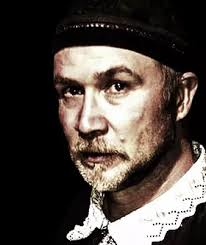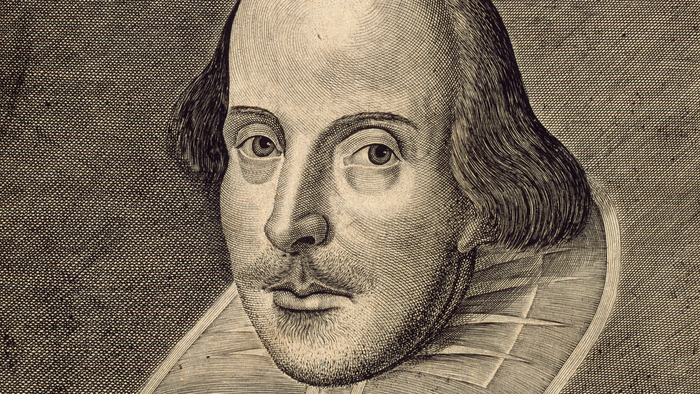Lucyna designed and hand-made the costumes using authentic designs and materials.
The lighting was based on the effects and muted colours. Later (than the time of the play) Dutch masters, the few authenticated (and disputed) potraits of Shakespeare, and the later self portraits of Rembrant provided materials to influence the look of the character.
Shakespeare wears a poet's smock, a Jacobean night cap based on one in the V&A museum and a courtly house robe, befitting his gentlemanly status and later status as a 'King's Man'. My legs were bare and the clothes grubby to accentuate an earthy pagan grounded feel, while Lucyna tried to give the gown a subtle catholic feel, the shirt was a puritan style design to reflect the spiritual convergance of influences in every psyche at the time.
Building the set at the Greenwood theatre
A broken suspended frame of a house and crooked askew furniture, to reflect the fragilty of theatre, the insubstanitiality of memory, a disrupted household and of a life spent building for the future. The design by director Lucyna Rossa was influenced by Cornelia Parker's exploded shed, 'Cold Dark Matter', reflecting the repeated imagery of shipwreck and decay that pervades the text.
The initial idea
I intended to challenge the mono-cultural Merry England of some ideological narratives and the pervasive mythos of a genius isolated from external influence or context.
Aware also that along with notions of race and national identity many patriarchal if not misogynistic elements of Elizabethan culture were deeply embedded within the works and life stories of Shakespeare I worked closely with Journalist Anne Dixey and Director Lucyna Rossa to help explore how notions of patriarchy and examples of misogynist tropes might be treated.
Gradually a narrative emerged of a successful but ailing man now out of fashion, unpicking his role and reaction to the culture exploring and becoming challenged by his own attitudes. Through the thought processes and research procedures described below kind of semi confessional mode emerged which recalled the notion that within the Protestantism of the times the recent tropes of Catholicism lay, not only within the culture but within Shakespeare’s family and psyche.
Living through the trauma of executions, starvation, plague and history a series of embodied habits underneath the protestant veneer lead to a confessional which provided a spectacle for women to reflect with men in the audience on masculinity itself.
Along aside this an awareness of queer theory offers another space for exploration of homo-erotic bonding, unspoken love, power and sexuality and male friendship. Notions of censorship, ageing creativity, celebrity, inherited power and stardom, are also relevant to the final piece
As are the material political questions that surround action, politics , how we make living and the constraints on art by power and hegemonic structures.
I explored narratives that took into account evidence based historical research, theoretical and informed textual analysis to explore a number of themes which gradually intertwined in a web of relationships which created the final piece. The resulting findings created a web of relations and aesthetic decisions which in different ways drew me closer to an idea of Shakespeare, his milieu and creative process.
I was interested in several areas of enquiry:
This theatrical work attempted:
A biographic portrait of William Shakespeare featuring him and his contemporaries as performing characters
It combined research into:
Historical records of the immediate politics of Stratford and London
Biographical research into his family,
Suppositions gleaned from textual analyses,
Examination of the power politics of patronage,
Events at court and nationally
Examination of the cannon of works describing the times
Writings of his contemporaries
Examination of Shakespeare’s own textual sources
Recent political and personal readings of his text and historical analyses of the influences of his plays.
At the time of writing archeological investigations of the Rose, New Place and the re-creation of the Blackfriars yielded insights into some aspects of theatre and domestic life these find their way into the text offering physical detail to augment the action.
I wondered how taking into account the pressures and form of times shaped by a police state, international paranoia and strict might re-contextualise our reading of what certain events and behaviours might mean.
I examined the materiality of his relations with properties, the new industry of theatre and the intrigues of court. These findings along with scrutiny of the various arguments that attempt to place his plays in order including those by those scholars that combine textual analysis with historicism like Greenblatt and Shapiro, with those predominantly British scholars that focus on the Biographical elements of his life like Jonathan Bate and Stanley Wells the reports and writings of contemporaries like Ben Jonson and those at court that offer us insight into wider perspectives
This list of major documented notes is published by the Folger library and amounts to the essential list of most commonly known primary biographic sources in Shakespare’s life. This list essentially provided a series of clear headings from which I could investigate the far more detailed inductive, and deductive scholarship that offers context to his life.
Rehearsal in the Vicars' Hall Windsor Castle
In smaller venues we adapted to the space using what we could of the environment but keeping our basic props. We removed anachronistic elements for the performance.
Rembrandt created approaching one hundred self-portraits including over forty paintings, thirty-one etchings and about seven drawings; they offer us a chance to look into the eyes of a great artist examining himself with great scrutiny, a useful parallel for the Shakepeare of 1616.
Cobbe portrait: In 2009, Stanley Wells and the Shakespeare Birthplace Trust claimed this painting, which has been in the possession of the Cobbe family since the early 18th century, as a portrait of Shakespeare drawn from life.
Droeshout engraving: portrait of William Shakespeare engraved by Martin Droeshout as the frontispiece for the title page of the First Folio collection of Shakespeare's plays, published in 1623
'Is it a home?
In name only,
It is an unfinished play-
A rabble of uneasy timbers edging stillborn dreams'
-1616
'I saw uncle’s head displayed
His lips: bloodless and blackened,
Taught me silence and equivocation
….
My plays have liquor for all thirsts:
I wrote the Jew’s pain, flattered his enemy,
Played grievances of king and commoner,
I’m catholic, protestant, faithful and faithless to all men-
With a penny for the takings.'











